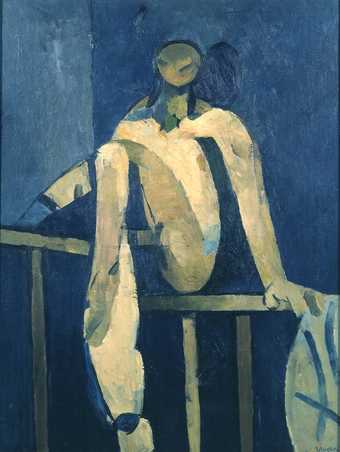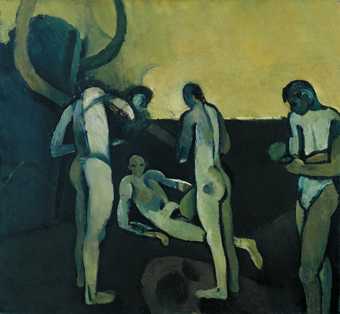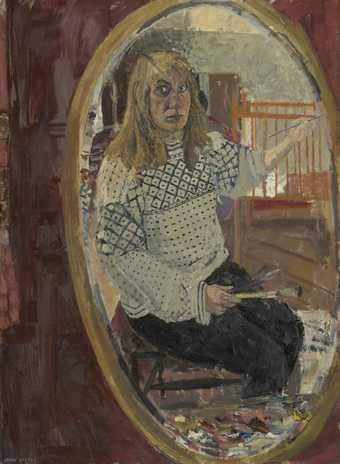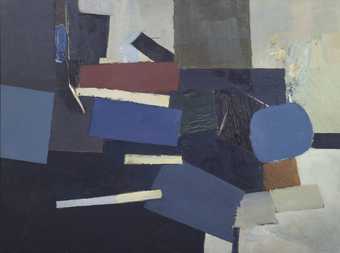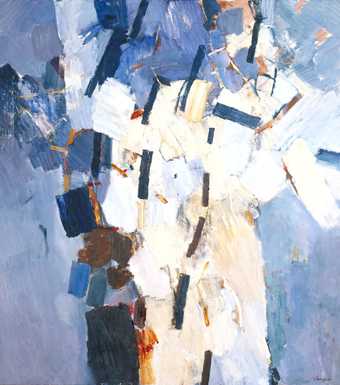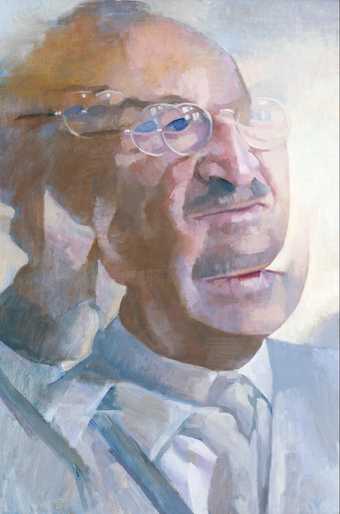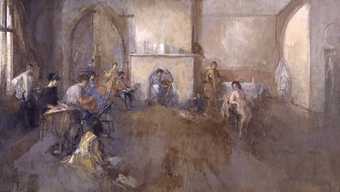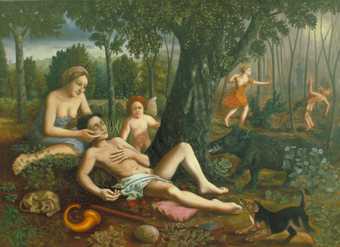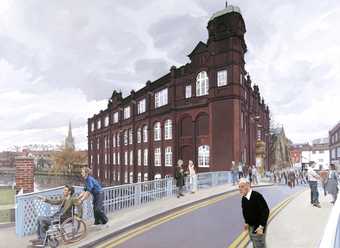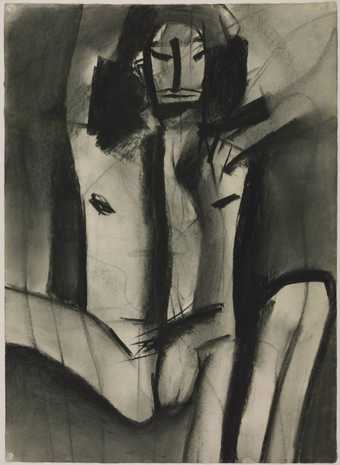
In Tate St Ives
- Artist
- Keith Vaughan 1912–1977
- Medium
- Oil paint on canvas
- Dimensions
- Support: 1150 × 1530 mm
frame: 1184 × 1562 × 50 mm - Collection
- Tate
- Acquisition
- Purchased 1983
- Reference
- T03700
Catalogue entry
T03700 Ninth Assembly of Figures (Eldorado Banal) 1976
Oil on canvas 45 1/4 × 60 1/4 (1150 × 1530)
Inscribed on reverse ‘ELDORADO BANAL/(9th ASSEMBLY OF FIGURES 1976)/45 × 60/Keith Vaughan/“Quelle est cette île triste et noire - c'est
Cythère/Nous dit-on un pays fameux dans les chansons/Eldorado banal de tous les vieux garçons/Regarde, après tout, c'est une pauvre terre”’
Purchased from Professor John N. Ball and Dr Gordon Hargreaves (Grant-in-Aid) 1983
Prov: Purchased by Professor John N. Ball and Dr Gordon Hargreaves from Waddington Galleries, 1976
Exh: Keith Vaughan, New Paintings and Gouaches, Waddington Galleries, March–April 1976 (no catalogue); British Painting 1952–1977, RA, September–October 1977 (371, repr.)
Lit: Linda Talbot, ‘Lost Legend’, Express and News, 26 March 1976; ‘Mr Keith Vaughan. An individualistic British painter’ (obituary), The Times, 8 November 1977; G. Hastings, Keith Vaughan, 1981 (unpublished B.A. thesis, University College of Wales, Aberystwyth, 1981, pp.67–71)
The ‘Ninth’ was the last of the paintings titled by Vaughan ‘Assembly of Figures’, and which had marked his production from 1952, the date of the ‘First’, as key works. It was painted in his studio in Belsize Park the year before his death, when he already knew he was suffering from cancer.
The composition was taken precisely from a small, undated, pencil drawing, 6 1/2 × 8 ins. The artist gave this to Professor Ball and Dr. Hargreaves when they jointly purchased the painting, and told them it was made much earlier. They date it on grounds of style to about 1960–2, and it was inscribed for them on the mount by the artist ‘To John and Gordon - March 1976 - Keith Vaughan - 9th Assembly of Figures’. The drawing is heavily worked, with many altered placings for the figures before it was finally shaded over. The main differences in the painting are that the central figure, painted dark blue, is barely visible in the drawing, and there is no suggestion of a landscape at the left, visible in the drawing as two ellipse shapes.
It is likely that this drawing was itself also connected to the verse from Baudelaire which is included in the title of the painting, since the artist confirmed to Professor Ball that the right hand hanging figure is that of the verse:
Perched on their provender, ferocious birds
were ravaging the ripe corpse hanging there.
He also identified the figure at the lower left, cut off by the frame, as himself pictured as an observer. The second verse, written in full on the reverse of the painting, also expresses disillusion with the ideal:
What is that dreary island - the black one there?
Cythéra, someone says, the one in the song
insipid Eldorado of good old boys:
it isn't much of a place, as you can see
(from Charles Baudelaire, Les Fleurs du Mal,
translated by Richard Howard, 1982)
Despite the reference to old age Vaughan had already used this verse for a drawing of 1942, not connected with the ‘Ninth Assembly’, titled ‘Voyage à Cythère’ and inscribed ‘Quelle est cette Triste Isle’ (exhibited The British Neo-Romantics, Fischer Fine Art, July–August 1983 (67)). He was also in 1942–3 making drawings from Rimbaud's Une Saison en Enfer. A later painting titled ‘Group of Figures, Eldorado Banal’ (1965, Huddersfield Art Gallery) equally has no connection in composition with the ‘Ninth Assembly’.
Published in:
The Tate Gallery 1982-84: Illustrated Catalogue of Acquisitions, London 1986
Explore
- abstraction(8,615)
-
- from recognisable sources(3,634)
- actions: postures and motions(9,111)
-
- arm / arms raised(839)
- sitting(3,347)
- suspended(20)
- man(10,453)
- group(4,227)
- male(959)
- self-portraits(888)
- arts and entertainment(7,210)
-
- artist, painter(2,545)
You might like
-
Keith Vaughan Leaping Figure
1951 -
Keith Vaughan Small Assembly of Figures
1951 -
Jean Cooke (Jean Bratby) Self-Portrait
1958 -
Keith Vaughan Rotherhithe
1961 -
Keith Vaughan Bather: August 4th 1961
1961 -
William Roberts The Vorticists at the Restaurant de la Tour Eiffel: Spring, 1915
1961–2 -
Sir Lawrence Gowing Portrait of Sir Norman Reid
1980 -
Peter Greenham Life Class
1979 -
Stephen McKenna Venus and Adonis
1981 -
John Wonnacott The Norwich School of Art
1982–4 -
Keith Vaughan Untitled (Male Figure)
c.1970 -
Desmond Morris The Arena
1976

